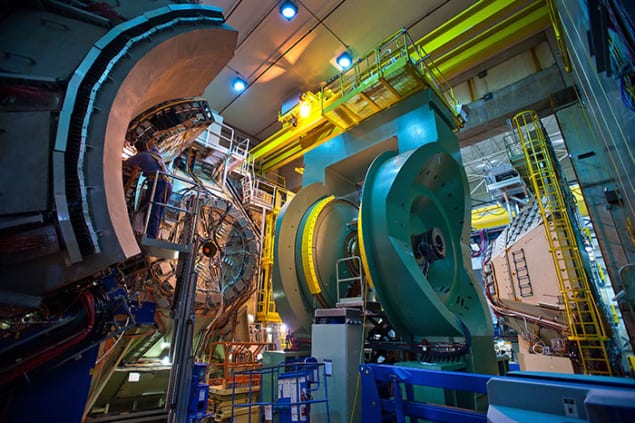
Researchers at the Relativistic Heavy Ion Collider (RHIC) at Brookhaven National Lab (BNL) in the US have discovered that when spinning protons collide with nuclei they produce neutrons that fly-off in different directions that depend on the size of the target nucleus. The physicists say that this unexpected observation suggests that the neutrons-producing mechanism is different for large and small nuclei. They add that this could have important implications for interpreting other high-energy particle collisions, including the interactions of ultra-high-energy cosmic rays with the Earth’s atmosphere.
RHIC has been operating since 2000 and is the only collider in the world with the ability to precisely control the spin polarization of colliding protons. During its first polarized proton run in 2001–2002 researchers discovered that when a proton with upward spin collides with another proton, the neutron produced in the collision prefers to emerge to the right.
Almost a decade later, in 2011, theoretical physicists published a paper explaining this result. But then in 2015 a PhD student at Seoul National University in South Korea and BNL, Minjung Kim, made a surprise discovery. She observed that when protons collided with gold nuclei – which are much larger than protons – they produce a neutron with a strong preference to travel in the other direction: to the left.
Completely unexpected
This change in directional preference was not predicted by the 2011 theory. “What we found from the collisions with gold nuclei in 2015 was not only that the asymmetry magnitude increased by a factor of around three, but also its sign flipped, with the preferred scattering direction changing from the right to the left,” Alexander Bazilevsky, a physicist at BNL and deputy spokesperson for the PHENIXcollaboration at RHIC, tells Physics World. “It was completely unexpected.”
To confirm Kim’s finding, PHENIX physicists worked on data analysis and detector simulations, and repeated the measurements under more precisely controlled conditions. These new experiments also included collisions between protons and aluminium nuclei, which sit between protons and gold nuclei in size.
The results confirmed that proton-proton collisions produce a directional asymmetry with more neutrons scattering to the right, while proton-gold collisions produce a stronger asymmetry with neutrons scattering to the left. And, collisions with the intermediate-sized aluminium ions produced neutrons with near zero asymmetry – a roughly equal number scattered in each direction.
Charged collisions
To explain their findings the physicists looked closely at the processes and forces affecting the scattering particles. They concluded that in proton–proton collisions the asymmetry is driven by interactions governed by the strong nuclear force, as described in the 2011 theory. In large nuclei with more positive electric charge, however, electromagnetic interactions play a much more important role in particle production than in collisions between two equally charged protons. Advertisement.
“We believe due to much larger electric charge of gold nucleus compared to proton, the electromagnetic interactions take on a larger role for neutron production in competition with strong nuclear interactions, with generated asymmetry of opposite sign to the one produced by strong nuclear interactions,” explains Bazilevsky. He adds that in medium sized aluminium nuclei the asymmetries generated by nuclear and electromagnetic interactions cancel each other out, and the result is no directional asymmetry in the resulting neutrons. “As our paper shows, the asymmetry sign flip happens around the aluminium nucleus, hence we would expect all nucleus lighter than aluminium would generate negative asymmetry (right preference), and all heavier nucleus would produce positive asymmetry (left preference),” he explains. Via - PHYSICS WORLD

No comments:
Post a Comment